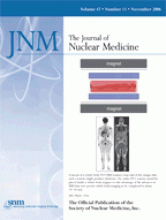Abstract
There have been major advances in PET technology that cumulatively have helped improve image quality, increased the range of applications for PET, and contributed to the more widespread use of PET. Examples of these technologic advances include whole-body imaging, 3-dimensional imaging, new scintillator materials, iterative reconstruction algorithms, combined PET/CT, and preclinical PET. New advances on the immediate horizon include the reintroduction of time-of-flight PET, which takes advantage of the favorable timing properties of newer scintillators; the integration of PET and MRI scanners into a dual-modality imaging system; and the possibility of further significant improvements in spatial resolution in preclinical PET systems. Sensitivity remains a limiting factor in many PET studies. Although, conceptually, huge gains in sensitivity are still possible, realizing these gains is thwarted largely by economic rather than scientific concerns. Predicting the future is fraught with difficulty; nonetheless, it is apparent that ample opportunities remain for new development and innovation in PET technology that will be driven by the demands of molecular medicine, notably sensitive and specific molecular diagnostic tools and the ability to quantitatively monitor therapeutic entities that include small molecules, peptides, antibodies, nanoparticles, DNA/RNA, and cells.
Footnotes
-
↵* Based on the presentation given for the Henry Wagner Distinguished Lectureship, 53rd annual meeting of the Society of Nuclear Medicine, San Diego, California, June 2006.







